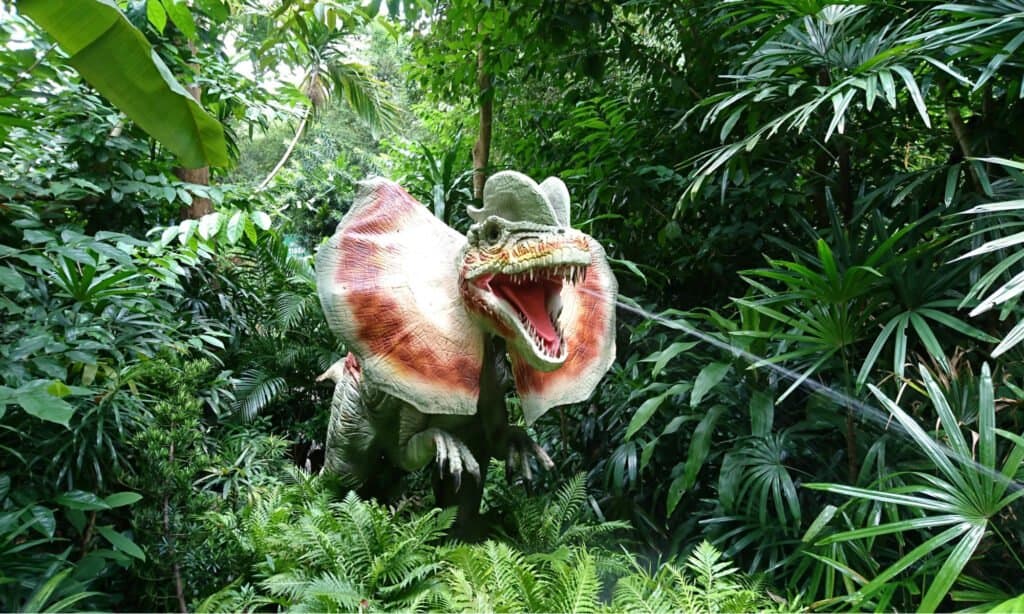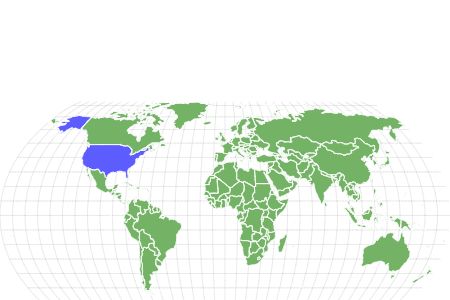Dilophosaurus
Dilophosaurus wetherilli
Dilophosaurus was the largest predatory dinosaur in North America during the Early Jurassic Epoch of the Jurassic Period.
Advertisement
Dilophosaurus Scientific Classification
- Kingdom
- Animalia
- Phylum
- Chordata
- Class
- Reptilia
- Order
- Saurischia
- Family
- Dilophosauridae
- Genus
- Dilophosaurus
- Scientific Name
- Dilophosaurus wetherilli
Read our Complete Guide to Classification of Animals.
Dilophosaurus Conservation Status
Dilophosaurus Facts
- Prey
- smaller dinosaurs and other reptiles
- Fun Fact
- Dilophosaurus was the largest predatory dinosaur in North America during the Early Jurassic Epoch of the Jurassic Period.
- Most Distinctive Feature
- The pair of keratin-covered crests on its head
- Distinctive Feature
- Inflatable air sacs for display
Dilophosaurus Physical Characteristics
- Weight
- 880 lbs
- Height
- 6 ft
- Length
- 23 ft
- Venomous
- No
- Aggression
- Medium
View all of the Dilophosaurus images!
Fans of the Jurassic Park franchise would probably recognize the Dilophosaurus as the frilled dinosaur capable of spitting venom at its prey. However, the real-life version of this dinosaur was remarkably different from this. This theropod dinosaur lived in North America during the early Jurassic Period, about 193 million years ago. It was a voracious meat-eater and was one of the earliest giant predatory dinosaurs.
Description and Size

The genus name
Dilophosaurusmeans two-crested lizard.
©Cheng Wei/Shutterstock.com
Dilophosaurus is a genus of theropod dinosaurs from North America’s Early Jurassic Epoch. The genus name means “two-crested lizard.” The dinosaur was given this name because it had a pair of prominent, arched crests positioned longitudinally on its head. The rest of the dinosaur’s skull was narrow and grew slimmer towards the rounded top. The head was large in proportion to the rest of the body, measuring as much as 23 inches in length.
Although often featured as a diminutive dinosaur, Dilophosaurus was one of North America’s largest early Jurassic Period dinosaurs. However, it was still slightly smaller than the theropod dinosaurs that came after it.
This dinosaur was slender with a light build. The largest specimen of the Dilophosaurus weighed about 880 lbs (440 kg) and was about 23 ft (7 meters) long. It stood at about 6 feet tall. Different interpretations have been given for the dinosaur’s prominent headgear. However, the most prevalent explanation was that the eye-catching feature had inflatable air sacs that the dinosaur used for sexual display. There are also speculations that this dinosaur might have had feathers. This is based on the interpretation of some impressions left, which appear to be feathers on some sedimentological artifacts.
Dilophosaurus had long, sharp teeth with a fairly small base that expanded towards the top. There were 12 teeth on the maxilla and 18 on its lower jaw. The second and third front teeth featured serrations, but these were absent in the fourth. One prominent feature of the Dilophosaurus‘ dentition was the notch behind the dinosaur’s first row of teeth. This is a feature in many crocodiles, and the notch suggests a weak connection between the dinosaur’s premaxillary and maxillary bones.
Diet — What Did Dilophosaurus Eat?
Dilophosaurus was one of North America’s largest carnivores during the Early Jurassic Period. However, the primitive predator lacked many advanced hunting features that later dinosaurs had. For instance, it did not have forward-facing eyes. This dinosaur would have relied heavily on a strong sense of smell to compensate for this lack of stereo vision.
Dilophosaurus had long-slender teeth that curved slightly to the back of its long jaws. While many scientists have interpreted their jaw structure as weak (labelling the dinosaur as a scavenger rather than a predator), other evidence suggests otherwise. For instance, their strong front arms were adapted with sharp claws to hold prey. A kink in the dinosaur’s upper jaw indicates that it could effectively hold on to struggling prey. Dilophosaurus was bipedal, but it was capable of moving very fast. Experts think it might have hunted in small packs.
Habitat — When and Where It Lived
Dilophosaurus lived during the Early Jurassic, about 193 million years ago. It was a terrestrial dinosaur, although some scientists believe it might have lived near the water and probably hunted for fish. Fossils of this dinosaur are common from Kayenta Formation, located in northeastern Arizona.
There are also speculations that this dinosaur lived and hunted together in small groups. Although there is no conclusive evidence for this, scientists have dug out several fossils of this dinosaur from the same location. The presence of crests on their hand also suggests a sort of social behavior or even hierarchy.
Threats and Predators
Dilophosaurus most likely ruled the North American continent for millions of years unchallenged. It was an apex predator, and none of the contemporary animals would have stood as a big enough challenge. It took millions of years before bigger predators like Allosaurus and the younger Tyrannosaurus rex came into the picture, and the Dilophosaurus was probably long gone by this time.
Discoveries and Fossils — Where It Was Found
In 1940, a local Navajo man discovered the first Dilophosaurus specimens near Tuba City, Arizona. Paleontologists collected two well-preserved fossils from this site.
In 1954, Samuel P. Welles assigned the species to the Megalosaurus genus and gave it the specific name “wetherilli” in honor of John Wetherill, a Navajo councilor. Ten years later, Welles found a larger and more detailed skeleton that showed the species had a crested skull. Based on this discovery, he reassigned the species to a new genus Dilophosaurus. Additional specimens, including footprints and other trace fossils, have been found in various locations in the United States.
Extinction — When Did Dilophosaurus Die Out?
The dilophosaurids were the apex predators in North America for several million years. The group of theropod dinosaurs started declining around 170 million years ago during the Late Jurassic. The exact course of their decline isn’t known.
Animals Similar to the Dilophosaurus
Similar dinosaurs to the Dilophosaurus include:
- Dracovenator: This is a dinosaur genus that lived in South Africa approximately 201 to 199 million years ago. Like the Dilophosaurus, Dracovenator was of moderate build.
- Sarahsaurus: This dinosaur was a primitive member of the sauropodomorph family. It lived around the same time as Dilophosaurus. However, it was an herbivore. Fossils of both dinosaurs were found in the same formation.
- Liliensternus: This is a genus of basal dinosaurs that lived during the Late Triassic Period about 210 million years ago. Fossils of this bipedal dinosaur have been found in present-day Germany.
Related Animals…
View all 110 animals that start with DDilophosaurus FAQs (Frequently Asked Questions)
When was the Dilophosaurus alive?
Dilophosaurus lived in North America during the early Jurassic period. The dinosaur was the dominant predator species between 201 to 174 million years ago.
How big was Dilophosaurus?
Dilophosaurus was a slender dinosaur with a light build. The most prominent member of this genus was about 6 feet tall and about 23ft long It weighed 880lbs (440kg).
Did Dilophosaurus have venom?
No. Despite being depicted as a venom-spitting dinosaur in the Jurassic Park movie, there’s no fossil evidence that Dilophosaurus (or any dinosaur) killed prey by spitting venom.
Thank you for reading! Have some feedback for us? Contact the AZ Animals editorial team.
Sources
- National History Museum, Available here: https://www.nhm.ac.uk/discover/dino-directory/dilophosaurus.html
- Scientific American, Available here: https://www.scientificamerican.com/article/the-real-dilophosaurus-would-have-eaten-the-jurassic-park-version-for-breakfast/
- Wikipedia, Available here: https://en.wikipedia.org/wiki/Dilophosaurus

















